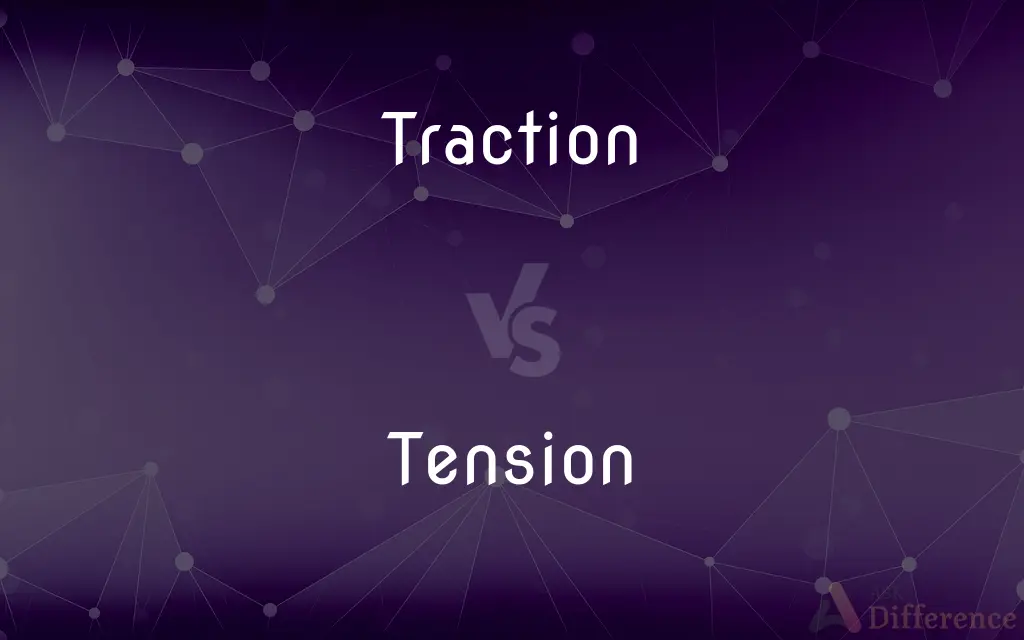Traction vs. Tension — What's the Difference?
By Fiza Rafique & Maham Liaqat — Updated on April 15, 2024
Traction refers to the force used to pull something along a surface, often to move or stretch it; tension is the force exerted when something is stretched or pulled tight.

Difference Between Traction and Tension
Table of Contents
ADVERTISEMENT
Key Differences
Traction primarily involves a force that pulls something along a surface, aiming to move or manipulate its position. On the other hand, tension describes the force exerted on a material or an object when it is stretched, often affecting the object’s internal forces and stability.
In medical contexts, traction is used to treat musculoskeletal disorders by gently pulling the bones and muscles to align and heal, applying a continuous force. Whereas, tension in this scenario might refer to the stress and strain muscles or ligaments undergo during this process or due to injury.
Traction can also apply to tires or footwear, emphasizing the grip and friction necessary to prevent slipping on surfaces. Conversely, tension can affect the durability and functionality of materials like cables and ropes, which must withstand pulling forces without breaking.
In physics, traction is discussed in terms of the mechanical advantage it provides, such as in pulley systems or vehicles. On the other hand, tension is a critical factor in engineering and physics, determining the load that strings, cables, or structural elements can support before failing.
Traction might be beneficial in applications like railway systems where it’s crucial for the motion of trains on tracks. Meanwhile, tension is essential in bridge construction, where suspension cables must be precisely tensioned to maintain bridge integrity and safety.
ADVERTISEMENT
Comparison Chart
Definition
Force used to pull objects along a surface
Force exerted by a stretched object
Applications
Medical treatment, vehicle dynamics, tire grip
Structural engineering, cable strength, material stress
Effects on Objects
Moves or stretches objects
Stretches, potentially deforming objects
Related Physics
Involves friction and mechanical advantage
Related to elasticity and material limits
Usage Examples
Traction control in vehicles, orthopedic traction
Tension in bridges, tension in strings and cables
Compare with Definitions
Traction
The adhesive friction of a body on a surface.
Good tire traction is essential for safe driving.
Tension
The state of being stretched tight.
The tension in the rope must be monitored to prevent snapping.
Traction
The act of drawing or pulling something over a surface.
The car's traction on the icy road was poor.
Tension
The degree of tightness of stitches in knitting.
Adjust the tension on your sewing machine for thicker fabric.
Traction
A method to achieve motion against resistance.
Traction engines were vital for early 20th-century farming.
Tension
Mental or emotional strain.
The unresolved conflict created a lot of tension in the office.
Traction
The ability to draw interest or attention.
The new product gained traction among teenagers quickly.
Tension
Pressure in a fluid or gas.
Steam builds tension inside the boiler.
Traction
A form of medical therapy using a pulling force.
The patient underwent cervical traction to relieve neck pain.
Tension
A force that tends to stretch something.
The cable can handle a lot of tension before it breaks.
Traction
The act of drawing or pulling, especially the drawing of a vehicle or load over a surface by motor power.
Tension
The act or process of stretching something tight.
Traction
The condition of being drawn or pulled.
Tension
The condition of so being stretched; tautness.
Traction
Pulling power, as of a draft animal or engine.
Tension
A force tending to stretch or elongate something.
Traction
Adhesive friction, as of a wheel on a track or a tire on a road.
Tension
A measure of such a force
A tension on the cable of 50 pounds.
Traction
(Medicine) A sustained pull applied mechanically especially to the arm, leg, or neck so as to correct fractured or dislocated bones, overcome muscle spasms, or relieve pressure.
Tension
Mental, emotional, or nervous strain
Working under great tension to make a deadline.
Traction
(Informal) Impetus or advancement, as toward a desired result
The bill gained traction in the Senate and was passed by a large majority.
Tension
Barely controlled hostility or a strained relationship between people or groups
The dangerous tension between opposing military powers.
Traction
The act of pulling something along a surface using motive power.
Tension
A balanced relation between strongly opposing elements
"the continuing, and essential, tension between two of the three branches of government, judicial and legislative" (Haynes Johnson).
Traction
The condition of being so pulled.
Tension
The interplay of conflicting elements in a piece of literature, especially a poem.
Traction
Grip.
Tension
A device for regulating tautness, especially a device that controls the tautness of thread on a sewing machine or loom.
Traction
The pulling power of an engine or animal.
Tension
(Electricity) Voltage or potential; electromotive force.
Traction
The adhesive friction of a wheel etc on a surface.
Tension
To subject to tension; tighten.
Traction
Progress in or momentum toward achieving a goal, especially in gaining support, recognition, or popularity.
Tension
The condition of being held in a state between two or more forces, which are acting in opposition to each other.
Traction
(business) The extent of adoption of a new product or service, typically measured in number of customers or level of revenue achieved.
Tension
Psychological state of being tense.
Traction
(politics) Popular support.
Tension
A feeling of nervousness, excitement, or fear that is created in a movie, book, etc.; suspense.
Traction
(academia) Scholarly interest and research.
Tension
State of an elastic object which is stretched in a way which increases its length.
Traction
(medicine) A mechanically applied sustained pull, especially to a limb.
Tension
Force transmitted through a rope, string, cable, or similar object (used with prepositions on, in, or of, e.g., "The tension in the cable is 1000 N", to convey that the same magnitude of force applies to objects attached to both ends).
Traction
(transport) Collectively, the locomotives of a railroad, especially electric locomotives.
Tension
Voltage. Usually only the terms low tension, high tension, and extra-high tension, and the abbreviations LT, HT, and EHT are used. They are not precisely defined; LT is normally a few volts, HT a few hundreds of volts, and EHT thousands of volts.
Traction
To apply a sustained pull to (a limb, etc.).
Tension
To place an object in tension, to pull or place strain on.
We tensioned the cable until it snapped.
Traction
The act of drawing, or the state of being drawn; as, the traction of a muscle.
Tension
The act of stretching or straining; the state of being stretched or strained to stiffness; the state of being bent strained; as, the tension of the muscles, tension of the larynx.
Traction
Specifically, the act of drawing a body along a plane by motive power, as the drawing of a carriage by men or horses, the towing of a boat by a tug.
Tension
Fig.: Extreme strain of mind or excitement of feeling; intense effort.
Traction
Attraction; a drawing toward.
Tension
The degree of stretching to which a wire, cord, piece of timber, or the like, is strained by drawing it in the direction of its length; strain.
Traction
The adhesive friction of a wheel on a rail, a rope on a pulley, or the like; as, the car is stuck in the snow because it can;t get any traction.
Tension
The force by which a part is pulled when forming part of any system in equilibrium or in motion; as, the tension of a srting supporting a weight equals that weight.
Traction
The friction between a body and the surface on which it moves (as between an automobile tire and the road)
Tension
A device for checking the delivery of the thread in a sewing machine, so as to give the stitch the required degree of tightness.
Traction
(orthopedics) the act of pulling on a bone or limb (as in a fracture) to relieve pressure or align parts in a special way during healing;
His leg was in traction for several days
Tension
Expansive force; the force with which the particles of a body, as a gas, tend to recede from each other and occupy a larger space; elastic force; elasticity; as, the tension of vapor; the tension of air.
Tension
The quality in consequence of which an electric charge tends to discharge itself, as into the air by a spark, or to pass from a body of greater to one of less electrical potential. It varies as the quantity of electricity upon a given area.
Tension
Feelings of hostility that are not manifest;
He could sense her latent hostility to him
The diplomats' first concern was to reduce international tensions
Tension
(psychology) a state of mental or emotional strain or suspense;
He suffered from fatigue and emotional tension
Stress is a vasoconstrictor
Tension
The physical condition of being stretched or strained;
It places great tension on the leg muscles
He could feel the tenseness of her body
Tension
A balance between and interplay of opposing elements or tendencies (especially in art or literature);
There is a tension created between narrative time and movie time
There is a tension between these approaches to understanding history
Tension
(physics) a stress that produces an elongation of an elastic physical body;
The direction of maximum tension moves asymptotically toward the direction of the shear
Tension
The action of stretching something tight;
Tension holds the belt in the pulleys
Common Curiosities
Can traction be beneficial in medical treatments?
Yes, traction is used in orthopedics to align and heal bones and muscles.
What is traction?
Traction is the force applied to pull something along a surface.
What is an example of tension in everyday life?
The tension on a violin string affects the sound it produces.
What role does tension play in engineering?
Tension determines the capability of materials like cables and bridges to withstand pulling forces.
How is traction used in vehicles?
In vehicles, traction controls the grip of tires on the road, essential for safe driving.
What devices are used to measure traction?
Devices like traction dynamometers measure the traction force applied in various applications.
What is tension?
Tension refers to the force exerted when an object is pulled tight or stretched.
Is there a relationship between tension and material properties?
Yes, the tension a material can withstand is directly related to its elasticity and strength.
How does tension impact structural stability?
Proper tension in structural elements like cables ensures stability and safety in constructions such as bridges.
How does traction affect safety in transportation?
Effective traction prevents vehicles from slipping on wet or icy roads, enhancing safety.
Why is traction important in sports footwear?
Sports footwear requires good traction to prevent athletes from slipping during performance.
Share Your Discovery

Previous Comparison
Database vs. Registry
Next Comparison
Your vs. ThyAuthor Spotlight
Written by
Fiza RafiqueFiza Rafique is a skilled content writer at AskDifference.com, where she meticulously refines and enhances written pieces. Drawing from her vast editorial expertise, Fiza ensures clarity, accuracy, and precision in every article. Passionate about language, she continually seeks to elevate the quality of content for readers worldwide.
Co-written by
Maham Liaqat















































